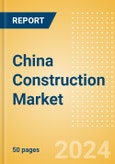Following an annual growth of 3.8% in 2024, The analyst expects the Chinese construction industry will maintain its growth trajectory, recording a growth of 3.2% in real terms in 2025. This growth will be primarily driven by developments in the infrastructure and energy and utilities sectors. In November 2024, the state-owned enterprise Xiongan High-Speed Railway initiated the tendering process for the development of a 468.5km high-speed rail line from Yichang to Fuling, China, with an estimated cost of CNY126.8 billion ($17.8 billion). Construction is scheduled to begin in March 2025, with completion expected in 2030. Furthermore, the Central Bank of China’s decision to cut interest rates in early January 2025 is expected to stimulate construction activity in the second half of 2025. However, the residential construction sector is likely to face challenges in the short to medium term, with low housing demand and rising debt among property developers potentially limiting overall industry growth. Investor confidence may also remain fragile due to the ongoing US-China trade tensions.
The analyst expects the construction industry to record an average annual growth rate of 4.1% between 2026 and 2029. This growth will be fueled by investments in transport infrastructure and industrial projects, alongside the government’s ambitious plans to achieve net-zero greenhouse gas emissions by 2060. In line with this target, the Shanghai local government aims to deploy 4.5 million kilowatts (kW) of solar capacity and accelerate the development of offshore wind power plants by 2027, in accordance with the Shanghai Action Plan for Accelerating the Green and Low-Carbon Transformation launched in September 2024. Additionally, in December 2024, as part of China’s 14th Five-Year Plan (2021-2025), the government approved the construction of the world’s largest dam on the lower reaches of the Yarlung Zangbo River, a project with a total cost of CNY975.6 billion ($137 billion).
The analyst expects the construction industry to record an average annual growth rate of 4.1% between 2026 and 2029. This growth will be fueled by investments in transport infrastructure and industrial projects, alongside the government’s ambitious plans to achieve net-zero greenhouse gas emissions by 2060. In line with this target, the Shanghai local government aims to deploy 4.5 million kilowatts (kW) of solar capacity and accelerate the development of offshore wind power plants by 2027, in accordance with the Shanghai Action Plan for Accelerating the Green and Low-Carbon Transformation launched in September 2024. Additionally, in December 2024, as part of China’s 14th Five-Year Plan (2021-2025), the government approved the construction of the world’s largest dam on the lower reaches of the Yarlung Zangbo River, a project with a total cost of CNY975.6 billion ($137 billion).
The Construction in China - Key Trends and Opportunities to 2029 (Q1 2025) report provides detailed market analysis, information and insights into the Chinese construction industry, including:
- The Chinese construction industry's growth prospects by market, project type and construction activity
- Critical insight into the impact of industry trends and issues, as well as an analysis of key risks and opportunities in the Chinese construction industry
- Analysis of the mega-project pipeline, focusing on development stages and participants, in addition to listings of major projects in the pipeline.
Scope
This report provides a comprehensive analysis of the construction industry in China. It provides:
- Historical (2020-2024) and forecast (2025-2029) valuations of the construction industry in China, featuring details of key growth drivers.
- Segmentation by sector (commercial, industrial, infrastructure, energy and utilities, institutional and residential) and by sub-sector
- Analysis of the mega-project pipeline, including breakdowns by development stage across all sectors, and projected spending on projects in the existing pipeline.
- Listings of major projects, in addition to details of leading contractors and consultants
Reasons to Buy
- Identify and evaluate market opportunities using our standardized valuation and forecasting methodologies
- Assess market growth potential at a micro-level with over 600 time-series data forecasts
- Understand the latest industry and market trends
- Formulate and validate business strategies using the analyst's critical and actionable insight
- Assess business risks, including cost, regulatory and competitive pressures
- Evaluate competitive risk and success factors
Table of Contents
1 Executive Summary2 Construction Industry: At-a-Glance6 Construction Market Data
3 Context
4 Construction Outlook
5 Key Industry Participants
7 Appendix
List of Tables
List of Figures








